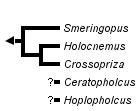Holocnemines
Dimitar Dimitrov


This tree diagram shows the relationships between several groups of organisms.
The root of the current tree connects the organisms featured in this tree to their containing group and the rest of the Tree of Life. The basal branching point in the tree represents the ancestor of the other groups in the tree. This ancestor diversified over time into several descendent subgroups, which are represented as internal nodes and terminal taxa to the right.

You can click on the root to travel down the Tree of Life all the way to the root of all Life, and you can click on the names of descendent subgroups to travel up the Tree of Life all the way to individual species.
For more information on ToL tree formatting, please see Interpreting the Tree or Classification. To learn more about phylogenetic trees, please visit our Phylogenetic Biology pages.
close boxIntroduction
The term "Holocnemus group" was first used by Timm (1976) to refer to the genera Artema and Holocnemus. Later on other authors have included or excluded genera from the holocnemines without phylogenetic argumentation. Modern phylogenetic studies that included broad samples of pholcids and holocnemine genera (Huber, 2000; Bruvo-Madaric et al., 2005) have found it problematic to delimit this group and have suggested an informal use of the name holocnemines.
Characteristics
Several synapomorphies have been suggested for this group (Huber, 2000). These are: reduced pseudosegmentation of the leg tarsi, presence of a pointed cheliceral lamina, and a procursus brush. Nonetheless, genera that have some or all of these characters, such as Artema, were placed outside the core holocnemines when molecular data was added to the analyses (Bruvo-Madaric et al., 2005).
Discussion of Phylogenetic Relationships
The tree presented here comes from the phylogenetic study of Bruvo-Madaric et al. (2005). This is the phylogenetic treatment which included the widest taxonomic sampling of holocnemines and used both molecular and morphological data. Bruvo-Madaric et al. (2005) confirmed the close relationships between holocmenines and pholcines suggested earlier by Huber (2000). The genera Artema, Physocyclus and Trichocyclus, traditionally treated as holocnemines, were found to be closely related to each other (Bruvo-Madaric et al., 2005) but their relationship with the rest of the long legged Pholcidae remains uncertain.
References
Bruvo-Madaric B., Huber B.A., Steinacher A., Pass G. 2005. Phylogeny of pholcid spiders (Araneae:Pholcidae): combined analysis using morphology and molecules. Molecular Phylogenetics and Evolution 37: 661-673.
Huber B.A. 2000. New World pholcid spiders (Araneae: Pholcidae): a revision at generic level. Bull. Amer. Mus. Nat. Hist. 254: 1–348.
Timm H. 1976. Die Bedeutung von Genitalstrukturen für die Klärung systematischer Fragen bei Zitterspinnen (Arachnida: Araneae: Pholcidae). Entomol. Germ. 3: 69–76.
About This Page
Dimitar Dimitrov

Zoological Museum, University of Copenhagen
Correspondence regarding this page should be directed to Dimitar Dimitrov at
Page copyright © 2009 Dimitar Dimitrov
 Page: Tree of Life
Holocnemines.
Authored by
Dimitar Dimitrov.
The TEXT of this page is licensed under the
Creative Commons Attribution-NonCommercial License - Version 3.0. Note that images and other media
featured on this page are each governed by their own license, and they may or may not be available
for reuse. Click on an image or a media link to access the media data window, which provides the
relevant licensing information. For the general terms and conditions of ToL material reuse and
redistribution, please see the Tree of Life Copyright
Policies.
Page: Tree of Life
Holocnemines.
Authored by
Dimitar Dimitrov.
The TEXT of this page is licensed under the
Creative Commons Attribution-NonCommercial License - Version 3.0. Note that images and other media
featured on this page are each governed by their own license, and they may or may not be available
for reuse. Click on an image or a media link to access the media data window, which provides the
relevant licensing information. For the general terms and conditions of ToL material reuse and
redistribution, please see the Tree of Life Copyright
Policies.
- First online 12 February 2009
- Content changed 12 February 2009
Citing this page:
Dimitrov, Dimitar. 2009. Holocnemines. Version 12 February 2009 (under construction). http://tolweb.org/Holocnemines/135166/2009.02.12 in The Tree of Life Web Project, http://tolweb.org/





 Go to quick links
Go to quick search
Go to navigation for this section of the ToL site
Go to detailed links for the ToL site
Go to quick links
Go to quick search
Go to navigation for this section of the ToL site
Go to detailed links for the ToL site